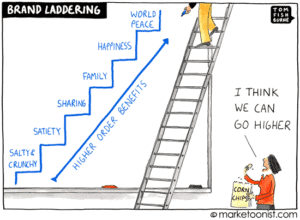‘Brand Laddering’ is one of the most frequently reached-for tools in the marketing communications box of tricks.
Simply put, you ‘ladder up’ from what are often rather boring product features or attributes (that are easily copied), to the benefits your product brings to your customers, and then (as you climb the ladder) to the world.
In other words, from a ‘me too’ to a ‘must have’ in the blink of a brainstorm.
What’s not to like? Just crack on, right?
Well, beware. There’s a real risk of going up the ladder too far.
Let’s start at the bottom.
Here’s an example.
You’re selling a product, or a service. It’s quite a common product, there’s loads of choice in the market. There’s nothing particularly special about the product – its features are largely the same as every other product of its type.
Let’s say you’re selling coffee.
Your coffee is made from a certain type of coffee bean, that produce a nice blend of acidity and bitterness. (PHYSICAL ATTRIBUTE)
The beans are lightly roasted to bring out their subtle flavours. (PROCESS FEATURE)
Which means that your coffee is nice and mellow with just enough zing to give you a bit of a lift. (PRODUCT BENEFIT)
Which helps you to start your day with a positive outlook, and smile on your face. (EMOTIONAL BENEFIT)
And we all know that when you smile, the world smiles with you. (HIGHER ORDER BENEFIT)
So, our coffee is making the world a happier place to live!!!!
A claim too far?
This Tom Fishburne cartoon identifies the problem perfectly.
We can do this with pretty much any product. Let’s try (just looking at what’s on my desk right now), staples.
Let’s get on that ladder.
Our staples are made with high tensile steel.
Which means that they’ll easily hold thick workbooks together without breaking. So, when you’re handing out homework to your pupils, they won’t fall apart in their bags.
Which means they’ll have everything they need to complete their assignment.
Which means they’ll get the education they deserve so they can take their place in society… and change the world for the better.
OR
Our staples are made with flexible steel.
That means when they’ve done their job, they’re easier to remove from documents.
Which makes recycling easier, lowering our carbon footprint…
And making the world a better place.
Brand laddering as an exercise is pretty easy (and fun) to do. But like anything we enjoy, it’s very easy to get carried away.
Go too high, and you’ll run out of oxygen
It’s important to remember that any claim we make needs to be rooted in reality. We can imply that a feature ladders up to the world being a better place, but it needs to be pretty subtle. We need to allow the customer to make that leap for themselves, or risk brand ridicule.
For example, in this 1986 Persil ad, product benefits aren’t even mentioned.
Persil = really white shirt = happy teenager = equilibrium at home = the world’s a better place.
But it’s never something that’s claimed by Persil. They allow the viewer to climb the ladder themselves.
On the other hand, let’s take a look at this 2014 effort from Starbucks.
Enduring love? It just feels like they’ve been climbing the ladder all the way up to the clouds.
Starbucks’ current mission statement is ‘to inspire and nurture the human spirit’.
Hmmm. Can coffee really do that?
I recently read good analogy for the idea of laddering – it’s like stretching an elastic band.
The more we pull, the more power is stored in it. But there’s always a point at which the pulling becomes too much – and the elastic snaps.
For Starbucks, this all feels like a bit of a stretch too far.
It’s fine to ladder up the benefits, it’s good to elevate your brand above your competitors – but be warned…
The problem with being up in the clouds, is that sometimes you can’t see the ground.


